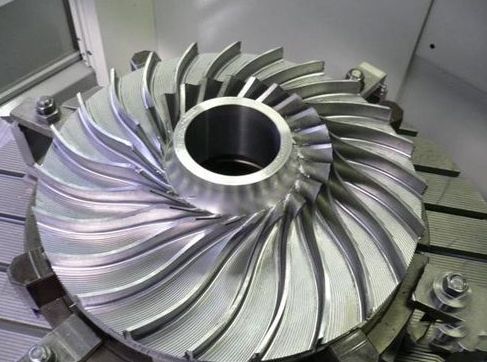Home >> NEWS >> Industry News
Application status of large aviation forgings materials |
Aviation forgings generally use materials with high specific strength and specific stiffness. Large aviation forgings mainly include titanium alloy, ultra-high strength steel and aluminum alloy. Titanium alloy for large aviation forgings Titanium alloy has been widely used in aviation industry because of its high specific strength, specific stiffness, corrosion resistance and other excellent performance, which has significant effects on weight reduction of aircraft structure and service life improvement of parts. Especially for military aircraft, some important structural components such as wing SPAR, frame, landing gear and so on are widely processed by titanium alloy forgings, with high single weight, large size and cross-sectional area. 
For example, the eight parts of the main landing gear support beams of Boeing B747 aircraft are forged with Ti-6Al-4V titanium alloy. Each piece weighs 1724 kg, has a length of 6.2m and a projected area of 4.1m2. Airbus A380 aircraft two six-wheel three-axle trolley main landing gear load beams are made of TI-1023 titanium alloy forgings, 4.255m long, weight 3210 kg. The frame of the fourth-generation fighter F22 developed by Lockheed uses Ti-6Al-4V ELI forgings, weighing more than 771kg and projecting an area of 4.06m2. At present, the main grades of titanium alloys for aviation are TC4, TC18, TC21, TA15, TB6 (American Ti-1023 alloy) and so on. TC18 is suitable for manufacturing large forgings due to its maximum hardenability. According to the needs of Boeing and Airbus, Russia developed ti-55531 titanium alloy on the basis of TC18 alloy by reducing the content of easy segregation element Fe. Ti-55531 has high strength, superior hardenability and wider processing window, and has been used in A380 hanger joints and landing gear struts and other parts. Domestic C919 aircraft also carried out the development of domestic materials, domestic heavy helicopters are also using this material to develop large helicopter hub central parts. The data collected so far show that: Compared with TC21 and TC18, Ti-55531 has higher tensile strength and lower plasticity and fracture toughness. However, ti-55531 has better crack growth resistance than TC21 and TC18 alloys under δ K =11 MPa·m12, indicating that its crack initiation life is longer and fatigue limit is higher. Suitable for long life design. Ultra high strength steel for large aviation forgings The steel with tensile strength greater than 1400 MPa and yield strength greater than 1200 MPa at room temperature is called ultra-high strength steel. It is usually required to have good plastic toughness, excellent fatigue performance, fracture toughness and stress corrosion resistance. Ultra-high strength steel for aviation is mainly used for key components such as landing gear, transmission gears, main bearings and butt bolts. In the early 1950s, China successfully developed 30CrMnSiNi2A ultra-high strength steel with a tensile strength of 1700MPa. In the early 1970s, 32Si2Mn2MoVA and 40CrMnSiMoVA steel were successfully developed based on China's resource conditions. Since 1980, the introduction of new technology from abroad, the use of new vacuum smelting process, has developed 34Si2MnCrMoVA (406A), 35CrNi4MoA, 40CrNi2SiMoVA (300M) and 18Ni martensitic aging steel. The research and development of ultra-high strength steel has laid a solid foundation for the development of China's aviation industry. With the continuous research and development of ultra-high strength steel, the development direction of ultra-high strength steel for large aviation forgings is as follows: (1) 2200 MPa grade and above ultra high strength steel. Plasticity, toughness, fatigue performance, crack propagation speed and resistance under the premise of ensuring strength. The comprehensive performance of stress corrosion is better than the widely used 300M steel. (2) Ultra-high strength stainless steel as an alternative material for the landing gear of the next generation of carrier-based aircraft. (3) Low-cost ultra-high strength steel, used for occasions with low performance requirements, such as civil aircraft, large uav, etc. Titanium forgings High strength aluminium alloys for large aviation forgings Aluminum alloy has been one of the main materials of aircraft body structure in aviation because of its low density, high specific strength, good corrosion resistance, good plasticity and machining performance, low cost and a series of advantages. Aluminum alloy used for aviation forgings in the world is mainly 2XXX series (2024, 2224, 2324, 2424, 2524, etc.) and 7XXX series of ultra-high strength (7075, 7475, 7050, 7150, 7055, 7085, etc.). 2XXX series aluminum alloy belongs to Al-Cu-Mg alloy, known as high strength duralumin, is one of the most widely used aluminum alloy, tensile strength of 400 ~ 500 MPa, than 7XXX series aluminum alloy at room temperature, but heat resistance, fatigue characteristics, especially fatigue crack expansion are better than 7XXX series aluminum alloy. Representative 2124 is widely used in the main structure of F22 and F35. 7XXX series aluminum alloy belongs to Al-Zn-Mg-Cu alloy, which has high specific strength and hardness, good corrosion resistance, high toughness and excellent machining performance. The typical representative is 7050 aluminum alloy, which is mainly used to strengthen the main bearing structure such as frame, bearing beam and joint in large aviation forgings. 7A85 aluminum alloy was prepared by microalloying and heat treatment system in China, and its properties are similar to those of 7085 aluminum alloy abroad. Compared with 7075, 7175 and 7050 alloys, 7A85 aluminum alloy greatly improves the content of Zn, reduces the content of Mg, and strictly controls the content of Fe, Si and other impurity elements, making 7A85 alloy maintain a high strength level, It also has excellent comprehensive properties such as good toughness, high fatigue strength and good stress corrosion resistance. Compared with 7050-T7452 forgings, 7A85 forgings have higher hardenability, with the depth of hardenability up to 305 mm, while 7050 forgings have a thickness of 203 mm, which is more suitable for manufacturing thick large section aviation parts. 7085 alloy has been successfully applied in the wing girder and rib structure of large civil aircraft A380. The wing girder is 6.4m long, 1.9m wide and 3.9t heavy, which is one of the largest aluminum alloy forgings in the world. |
